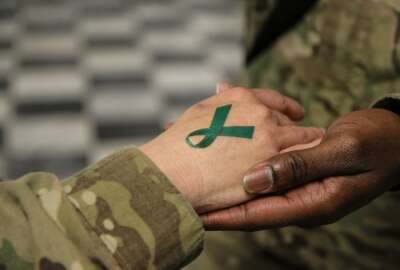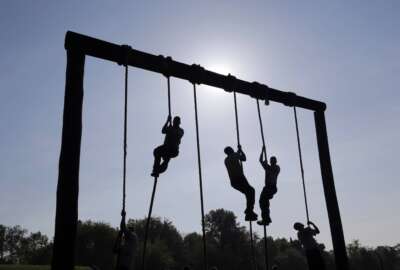Nowhere safe to hide: What online harassment is doing to service members and the military
Social media and text messaging are now a way of life for people in the military — they use the services to keep in contact with friends, for recruiting, to d...
(Click above to listen to the audio documentary version of Nowhere Safe to Hide. Contains explicit language.)
Editor’s note: This article contains explicit language and references to sexual situations and abuse.
“It is simply too early in the goddamn morning for unsolicited dick pics.”
That tweet, sent around 8 a.m. on Dec. 30, 2021, was an impassioned stance from a woman working for the military who had reached her limit with online harassers, shortly after a Marine allegedly sent her a picture of his genitals without her consent.
The tweet started a maelstrom of discussion about online harassment of and by military service members. Women service members quickly began talking about their experiences with cyberharassment from fellow troops. The picture is just a snippet of what many people in the military community, especially women service members, face every day when they pick up their phones or get on their computers.
Social media and text messaging are now a way of life for people in the military — they use the services to keep in contact with friends, for recruiting, to do their jobs, to find like-minded people or just to show their mom what they did today. Those platforms are also wrought with sexual harassment, bullying, hazing and intimidation directed at troops and perpetrated by them.
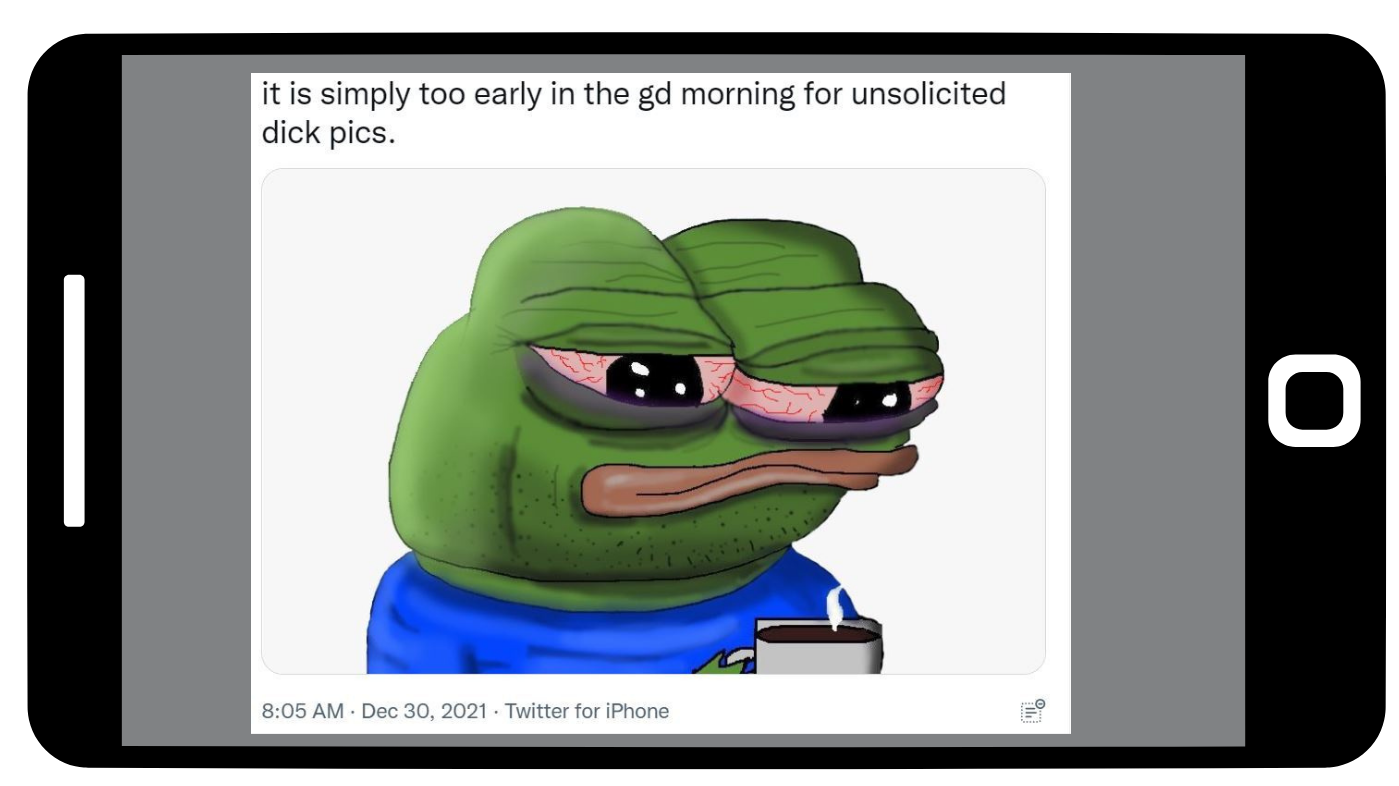
Sexual advances, crude jabs, attacks and even doxxing — a practice where a person’s personal information is leaked publicly on the internet — bombard service members, especially women, daily on the internet.
The Defense Department and the military services promise to reinforce a positive command “free of misconduct or the appearance of condoning misconduct,” as one letter regarding social media signed by the top Army officials in 2017 explains. But in reality, as seen through Federal News Network’s years-long investigation, service members see a disconnected leadership bloc that only pays lip service to caring about internet intimidation.
Meanwhile, troops are feeling the weight of attacks from peers, veterans and civilians through direct messages, texts, calls, video chats, public posts and internet forums. Equally, service members are harassing their peers, often without consequences, through those platforms, troops, veterans and advocacy organizations tell Federal News Network. Those attacks have an effect on recruitment, retention and the mental health of troops, according to studies funded by DoD, and private organizations following the issue.
However, the Pentagon does not have any active data on cyberharassment or who is doing it.
“A pattern of denigration”
Tammy Smith, who formerly served as the Army’s top military personnel official, said the online harassment women service members face is nearly endless.
“You are subject to a pattern of denigration of what it means to be a woman in the military, and a constant pattern of people who come in there specifically to put down or talk poorly about women in the military and minorities in the military,” she said.
The Pentagon refused multiple requests to talk on-the-record with Federal News Network about online sexual harassment. Federal News Network then sent written questions to DoD and three more emails requesting information over a course of weeks, but the department did not respond.
While the Biden administration recently signed an executive order making sexual harassment explicitly punishable under the Uniform Code of Military Justice in the military, currently the Pentagon and military services keep very little data on online harassment such as how often it’s happening, in what ways, what ranks and services harass the most or even how many online forums there are sharing offensive material. Analysts familiar with the issue told Federal News Network that the military has minimal insight into who is committing online harassment and rarely goes after offenders of the military services’ social media policies.
What it took to sniff out the Marine who allegedly sent the picture of his penis and get his command’s attention was at least 30 women, the second highest military official in the Minnesota National Guard, along with contact from the Marine’s former command.
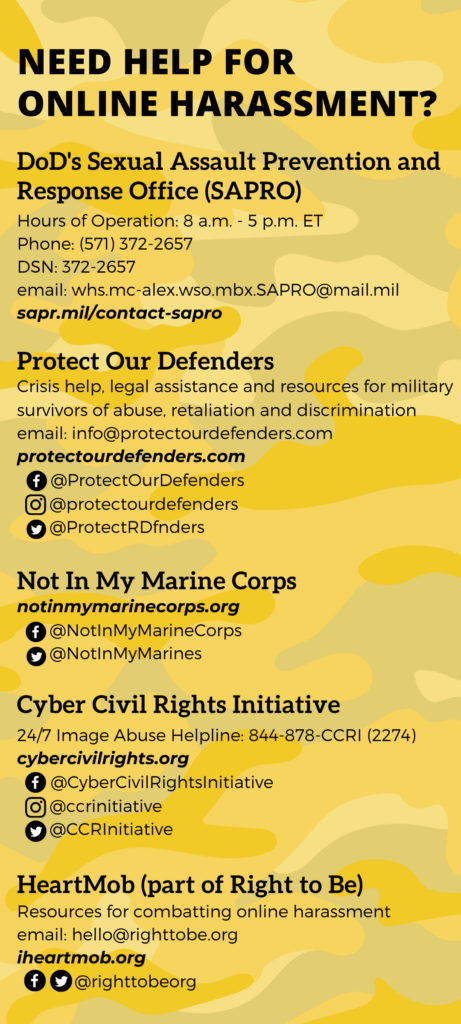 A painful bond between women
A painful bond between women
After the woman tweeted about the unsolicited picture, and named the Marine who sent it, other women — civilians, veterans, active duty military and even ROTC cadets — came forward with their own stories about the Marine.
Federal News Network tried multiple times through Twitter and Linkedin to contact the Marine for comment and received no response.
“We decided to form this group chat,” said Sarah, one of the women in the chat. Federal News Network has changed her name to protect her identity due to the nature of online harassment. “We had, at one point, about 30 different women in this group chat, plus at least 10 others who had commented and expressed that he had either made them uncomfortable, that he had flirted with them or he had, in some way, tried to insert himself into their lives.”
The Marine Corps confirmed that the Marine in question is under investigation and could not comment further due to privacy rights afforded to uniformed members. The Marine Corps refused an interview to talk generally about online harassment, but did send a statement.
“Harassment of any kind has no place in the Marine Corps. Incidents of harassment weaken trust within the ranks, erode unit cohesion, jeopardize combat readiness and mission accomplishment, and will not be tolerated, condoned, or ignored,” Capt. Ryan Bruce, a Marine Corps spokesman said.
The Marine, who went by the now defunct Twitter handle @usemcee, would frequently groom women by offering to be a mentor to them on military matters — giving tips, mental health support and other guidance, according to people who were in contact with him online.
“It started with him presenting himself as a mentor and experienced staff sergeant, noncommissioned officer in the Marine Corps willing to offer advice, willing to listen to them and hear what was going on and give them a helping hand as they needed it,” Sarah said. “And then for every single one of these women, he then turns it into flirtation and making sexually aggressive comments toward them. The 18-, 19- and 20-year-old junior service women who are college ROTC cadets, those were the ones that were most concerning to me; to find out that he had pursued sexual relationships with them.”
@usemcee would offer to get “blackout drunk” with them, Sarah said. The woman who tweeted about the explicit picture also tweeted about his tendency to ask women to get overly intoxicated with him.
The cost of stepping forward
“Y’all have no idea how hard this was for me. It took me two days to finally post it, bc i hate confrontation,” the woman who received the picture tweeted. “I hate having to explain to men in their mid-30s that their predatory behavior isn’t okay, so.”
It’s especially hard when resources seem to be absent from the discussion around online harassment. While @usemcee’s command reached out to the women, they still needed to file a report, and that can be a scary and daunting task for women concerned about their status in the military.
There’s a stigma for women who come forward with sexual harassment and assault reports, Sarah said.
“There were still several women who said, ‘I’m really sorry, but I can’t report this to my command because they already don’t like me, and they’re going to treat me like I’m creating a problem,’” Sarah said. “These younger, junior ranking women don’t have power in these situations. They don’t have the power to even get justice for themselves. The Department of Defense doesn’t seem to have a good answer for it.”
A RAND Corporation study published last year found that only 27% of sexual assault victims reported their assault. A total of 31% of men and 28% of women assaulted said they experienced retaliation even if they didn’t report what happened to them. For those who do report, 52% say they experienced retaliation. There are no retaliation numbers for harassment, let alone for online harassment. RAND said that DoD’s recordkeeping of retaliation for assault is dubious, and the numbers are likely higher than what is reported.
DoD has put a heavy emphasis on sexual assault and harassment in the past years. However, numbers remain high. A survey of active duty service members conducted by the Defense Department in 2018 — the last known count of harassments — found that about 119,000 individuals in the military experienced sexual harassment in the previous year. That is roughly 1 in every 10 active duty service members.
Despite the emphasis, congressional hearings, new policies and leadership’s promise to crack down, only one general out of the hundreds in the military attempted to step in to address an issue that was blowing up the Twittersphere known as #miltwitter, where leaders, service members, veterans and policy wonks frequently banter.
A day in the life online
On Jan. 1, Maj. Gen. Jo Clyborne, the assistant adjutant general of the Minnesota National Guard, tweeted about the @usemcee incident, “If you know the identity of the NCO who was DMing inappropriate pictures please DM me that individual’s information and unit if known.”
Clyborne told Federal News Network she was just doing her job in reaching out.
“I can’t say I’ve received any classes or training on social media harassment from the military, but you know what ‘right’ looks like, and you know what ‘wrong’ looks like,” she said. “I don’t worry about what other leaders do. I worry about doing what I’m supposed to do in order to lead the formations that I lead with my actions and reactions. At that time, I felt that was the best course of action. My job isn’t to go digging into the facts or to investigate. I’m a couple of levels removed from that. But we teach our junior people from the very day they enter our military, that if you see something, to say something.”
Clyborne is familiar with what wrong looks like; even in her high-ranking position she is harassed online.
Clyborne maintains three jobs: She runs a law firm; she’s the assistant adjutant general of Minnesota; and she’s the deputy commanding general of the Army Cyber Center of Excellence at Ft. Gordon, Georgia.
Recently, Clyborne had her nails done as part of an event she attended as a lawyer — something she rarely does — and sent out a tweet about how she was sad she had to take off the polish before she can get into uniform the next day because the color was not up to code.
Why the Army thinks a French Manicure is an “obnoxious” color compared to the civilian world which views it as an understated yet professional look is beyond me. But I have to be in uniform tomorrow, so here we are. It looked nice while it lasted. pic.twitter.com/GOxjDHbROR
— Maj. Gen. Jo Clyborne (@joclyborne) October 15, 2021
“I was absolutely drug through the mud for that tweet,” she said.
One commenter wrote, “At least 51% of the population believes Major General Jo Clyborne is an atrocity to the entire USA, with or without nail polish.”
Another wrote, “I bet your cookies are delicious!!!! How are your vacuuming skills?”
But Clyborne also knows that what she gets is light compared to the threats and harassment more junior service members, especially women, get every day and sometimes with nearly every post they put online.
“I don’t hear our male leaders having similar experiences,” she said. “They do get threats; they do get obvious comments that are inappropriate. But usually not to the extent that our female leaders do.”
A troubling trend
Federal News Network watched social media over a course of two years to see how women service members are treated by frequently checking #miltwitter, browsing forums maintained by service members for service members, sorting through comments on Facebook groups and monitoring TikToks service members created. Federal News Network also worked with military sexual trauma groups to review documented examples of online harassment and interviewed multiple service members about their experiences.
“If you’re a woman in any regard and you post in uniform, other service members will comment that you are a walking Sexual Harassment/Assault Response and Prevention case,” said Emily, an active duty service member who has more than 220,000 followers on TikTok. “There are statements about women only being in the service only to orally satisfy the male soldiers.”
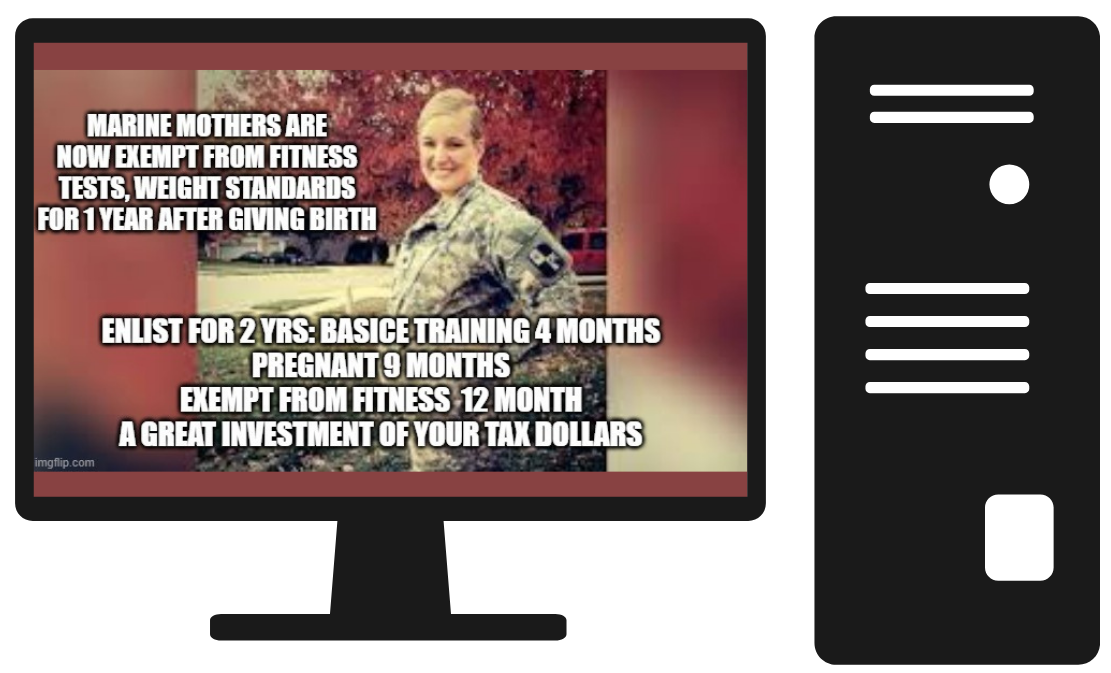
After watching social media, speaking to victims and listening to experts, Federal News Network learned that the experience women service members have online can often be hostile. They are harassed daily about being pregnant, not being pregnant, being too pretty, not being pretty enough. They are talked down to, called sweetie. Women service members are explicitly threatened with rape, with murder and with torture. They are told to stay in the kitchen, to make sandwiches. They are called barrack bunnies. Their home addresses are posted online and people drive by their house. Forums and groups are created to share naked pictures, sexist memes and to gang up on women.
The service member who tweeted about receiving a lewd picture on Dec. 30, 2021, got a harassing comment on the very post where she called out the behavior. The commenter wrote, “You sure you don’t want some foreskin with your coffee? Lmao.”
“When it comes to degrading women online, it’s incredibly common,” said Don Christensen, president of Protect our Defenders and former chief prosecutor for the Air Force. “Any woman who identifies herself as either currently serving or as a veteran is opening themselves up to a barrage of harassment, things like — women shouldn’t be in the military, you’re not a real soldier, you haven’t deployed or if you have deployed then you haven’t seen combat. If you were to talk to women who have accounts that have a lot of followers, they would verify that that is an all too common problem with them being subjected to misogynistic attacks.”

Erin Kirk-Cuomo, co-founder of Not In My Marine Corps, former Marine and photographer to the commandant of the Marine Corps, said online harassment and retaliation are simply a fact of being a woman in the military.
“When I say 99.9% of women service members, or people who identify as women, have been sexually harassed online or inappropriately sexually contacted online by superior officers or enlisted members, that’s not an exaggeration,” she said. “Almost every single woman has had to go through this.”
And when they call it out, service members often do not come to their aid.
“Throughout that whole week of the @usemcee incident you still continued to see active duty members, men, coming to this guy’s defense saying ‘Oh, you’re just blowing this situation out of proportion. This is ridiculous. This is why women in the military have a bad name. This is why they don’t want women serving in the military. This is why you’re all drama.’” Kirk-Cuomo said. “Basically gaslighting every single one of those women and trying to make them feel that they were overreacting to their personal experiences of sexual harassment.”
The effects of harassment run deep
When it comes to the effects of online attacks, harassment in general can be devastating to those on the receiving end.
Another RAND study from 2021 found that women service members in environments with high sexual harassment had a 1.5 times higher risk of being sexual assaulted; it was 1.8 times higher for men who were harassed.
Terry Schell, lead author of the report, said it was already established that sexual harassment and assault in the military were closely linked, but that the study was the first to factor in environment as well.
The Independent Review Commission on Sexual Assault in the Military said in its report to DoD that subcultures of misogyny thrive online.
According to an extensive compilation of multiple studies by the National Institutes of Health, cyber harassment has traumatic consequences for mental health, including depression, anxiety, suicidal ideation and panic attacks.
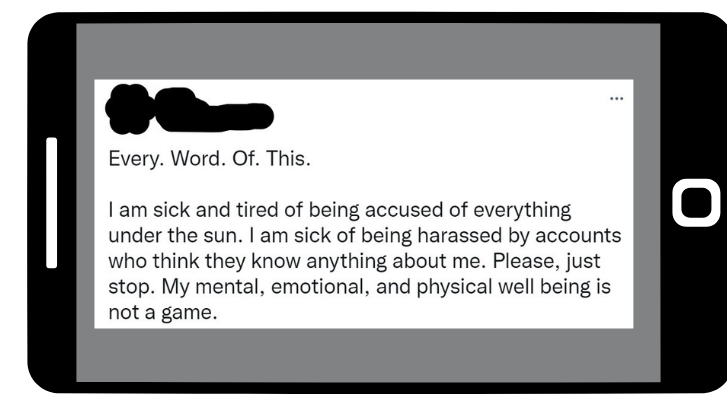
“For a lot of people it could definitely be what sends them off the edge,” Emily said. “Some people don’t even make it to the end of their end of service date. They just freaking kill themselves because it gets that bad. Women join the Army to be an asset to the country. They intend to be someone that contributes greatly, but being treated as someone who’s dispensable and not valuable at all.”
Finding tragedy in the midst of military harassment isn’t hard. One of the most high-profile cases is that of Spc. Vanessa Guillén. The military dismissed multiple reports of Guillén’s harasser before she went missing. At 20-years-old, she was bludgeoned to death with a hammer by a fellow service member, Spc. Aaron Robinson. Her body was moved off base, dismembered, burned and then buried at three different sites.
What DoD is doing, and what it isn’t
“Why wasn’t I talking about this?” former Marine Corps Commandant Gen. Robert Neller asked himself in front of the press at the Pentagon in March 2017. “I don’t have a Facebook page, OK? I don’t do social media, all right? And that’s maybe my mistake.”
Neller said that after it was discovered that more than 30,000 active duty and retired members of the Armed Forces were sharing nude photos of female service members online without their consent.
It was a wakeup call for the military, and the services rushed to put out social media policies that promised they were taking a tough stance on online harassment.
But, despite all the evidence that online harassment is still alive and well, DoD doesn’t have much to show for its policies when it comes to documenting the issue.
Data on online harassment, investigations, prosecutions and reprimands is not available. After being given more than a month to answer questions about online harassment and being asked to provide any data on it, the Pentagon has not answered Federal News Network’s request.
Still, according to the aforementioned sources’ testimony and evidence Federal News Network reviewed, online harassment is witnessed by commanders, service members, civilians and vets every day.

Kirk-Cuomo and Christensen confirmed that numbers on online sexual harassment in the military likely don’t exist. While DoD is capable of tracking nearly every object in orbit around the earth the size of a softball or larger, it is unable or unwilling to catalog cases of online harassment.
In 2017, the personnel chiefs of each military service took questions for the record from lawmakers on how many people had been punished for violating social media policies. Each service answered by saying social media is an emergent issue and there is no centralized system of records or database that captures all allegations of misconduct of this nature, nor is there any system that captures the full range of judicial, non-judicial and administrative actions that may have been exercised by individual commanders, commanding officers and officers in charge. The Marine Corps did provide the number of troops under investigation for sharing photos at the time: at least 116.
There is no evidence of any updates or further attempts by DoD to improve its recordkeeping on the issue. The closest is a voluntary, self-reported survey of service members in which 30% of women who said they were sexually harassed noted that they had been specifically sexually harassed online. That excludes other types of harassment.
The independent commission on military sexual assault noted that cyber harassment is prone to underreporting because individuals do not trust that the system will meaningfully address their case.
“I don’t think DoD wants to keep statistics because it’s going make them look bad,” Kirk-Cuomo said. “There’s really no statistics on this. It’s been really hard to track, especially online. If you’ve lived it, you know that everybody goes through it.”
Not In My Marine Corps is forwarded links every day to whisper networks sharing nude photos without consent, just like in the Marines United case, plus instances of doxxing, physical threats, racist taunts and everything in between.
“I haven’t seen anything that indicates to me that any of the investigative agencies are proactively looking on the internet to try to find these things,” Christensen said.
Confusion at top levels
Part of the issue is that DoD and the military services’ guides just aren’t up to date with the constantly changing dynamics and trends of social media.
“There’s no real solid, clear definitions or policies around what service members should or shouldn’t, or can and can’t do with regards to online activity,” Kyleanne Hunter, a member of DoD’s independent review commission on sexual assault in the military. “The focus of social media training and online activity training is really focused on sharing classified information, don’t share things that are sensitive or classified, don’t get people in trouble.”
Before the executive order on sexual harassment in the military from President Joe Biden in January, harassment was lumped in with other charges like behavior unbecoming of an officer or failure to follow an order. Only unlawful distribution of photos had its own category. That makes it hard for data on harassment or online harassment to track.
Kirk-Cuomo, of Not in My Marine Corps, said if someone were to request records of all the general charges harassment might be prosecuted under, then they would have to sift through a landfill of other behaviors like DUIs and vaccine refusals. The article is legally broad and encompasses everything from cruel and immoral actions to being dishonest.
The new executive order brings some hope to sifting through prosecutorial data. Sean Timmons, a managing partner at the law firm Tully Rinckey, who specializes in military law, said the order creates a specific charge for sexual harassment.
“It’s just basically semantics, in all honesty, because sexual harassment has been criminalized in the military for more than 30 years, they just didn’t specifically identify it as an enumerated offense,” Timmons said.
The change could broaden the scope of what the military is willing to prosecute. The Pentagon has more violations to put on paper when charging someone and that puts the defense in more of a bind. Timmons said the new classification could be one way to increase online harassment prosecutions.
The independent commission on sexual assault noted in their recommendations that DoD needs to collect data to measure the problem of online harassment and its related harms.
“DoD and the services lack the ability to track the prevalence of cyberharassment, online stalking and retaliation, and other technology-facilitated abuse, such as the non-consensual distribution of intimate digital images,” the commission wrote. “Without a systematic, targeted approach to collecting data on harassing and harmful behaviors in the cyber domain, DoD and the services will lack information critical to informing prevention measures.”
Accountability is scarce
Outside of collecting the data, the Pentagon has to actually prosecute these cases and most signs, at this point without solid data, show that it’s not happening often. Of course, DoD can only prosecute service members who are harassing other service members due to the scope of its authority.
The commission authors state in their report that, “While DoD and the services address the online environment in their harassment policies, accountability remains scarce.”
Actually finding the harassers is one of the most complex issues for DoD, according to Christensen. Perpetrators can create anonymous burner accounts that make it hard to figure out who is behind the avatar.
“Who is this person that is doing these things? How do we find out who this person is?” Christensen said.
Before the 2022 defense authorization act, investigations were handed off from a command to whoever had time to do the work, leading to shoddy detective work, Christensen said. That is changing now with the new law creating a special investigations unit for sexual assault and harassment in the military. That law will move that work out of the chain of command, where an officer who specializes in assault and harassment and has no ties to the command and people being investigated will handle the case.
DoD set a timeline for some of its sexual assault reforms laid out by Congress and the review commission on sexual assault. Many won’t be finished until 2027, a schedule that is under scrutiny by lawmakers like Sen. Kirsten Gillibrand (D-N.Y.)
However, investigators also need the cooperation of the command. If the command isn’t willing to look into details of who the poster might be — like identifying factors in messages — the offender would be able to stay under the guise of anonymity.
Outside of that, Christensen said, if the harasser doesn’t make it clear who they are, “I don’t know how you would ever identify them short of subpoenaing Twitter to find out who the person is, which can be problematic.”
Kirk-Cuomo described DoD as an ostrich with its head in the sand when it comes to online harassment, and often leadership is still causing controversy on how it’s handled.
A TikTok story of culture divide
One particular incident gained traction on MilTok, the section of TikTok used by service members, when an Army specialist at Ft. Hood, who goes by @dont_mindg, posted a video of a soldier’s fatigue pants around his ankles stating that a woman was trying to climb the ranks.
Emily, the active duty service member who has hundreds of thousands of followers on TikTok, posted a response to the video, calling out the soldier for harassing women.
@savannahglembin happened to me while I was active and to so many other women I know, I’m so sorry @_the_joel_ #military#militarywomen#army#marine#feminist#strongwomen ♬ original sound – Savannah Glembin
“I said ‘Hey, if you have a female soldier working under you how protected and mentored and safe is she going to feel in a work environment where her boss is posting stuff like this? Or expecting stuff like this out of his female soldiers?’” Emily said.
A soldier from a completely different base saw Emily’s TikTok critiquing the TikTok and complained to her command about her videos; Emily’s videos do not violate any military codes or TikTok terms. While many other soldiers thought Emily’s post was constructive and added to the discussion of harassment, her leadership took the complaint to heart. Emily’s command made her take down all of her videos with her in uniform and forbade her from posting further in uniform.
“She did the right thing in calling him out. She kept it tactful and professional,” one post on the Army Reddit with hundreds of comments said. “She was told to take all her videos in uniform down and to not post in it anymore. All because she did the right thing. Is this the Army we are part of? How we supposed to trust our leaders when they do BS like this? This is not okay. We need to do better.”
While this was happening, @dont_mindg had not been reprimanded or investigated; the Army later said it began an investigation immediately after learning about the video on Jan. 7.
Eventually, Emily’s command reversed its decision.
Hunter, the member of the independent review on sexual assault, said most leaders are out of touch with the internet culture of their subordinates.
“There’s quite frequently a large generational divide as to how the more junior members, both enlisted and officers, view the digital world and how most of the senior leaders do,” Hunter said.
Since the Marines United incident, leaders are making more of an effort to engage online, but they are still largely insulated from what junior officers are doing.
“There is a lack of understanding about the social media realm by senior leaders,” Smith, the former Army major general, said. “We didn’t grow up in social media; some of us adopted it later on. We don’t understand the experiences of young people who grew up with it. Social media was the place that they went, that was as familiar as going to ballet lessons or going to the playground.”
Congress asked former Marine Corps Commandant Neller in the wake of the Marines United scandal how to hold offenders accountable. He said he didn’t have a good answer.
The sexual assault commission noted that senior leaders’ limited digital literacy keeps them from fully understanding their junior members and the impact of online harassment.
What DoD needs to change
The expectation from the Pentagon is to uphold the positive command structure it promises to keep service members from preying on each other, Kirk-Cuomo said.
“What really needs to happen is now that we have this specific UCMJ article on harassment, they need to utilize it, these people need to be held accountable,” she said. “If you want to act like this, you want to destroy our morals and our values that we stand for and the good order and discipline, then you don’t belong in the military. Goodbye.”
The independent review commission outlined three recommendations that DoD should follow to begin clamping down on online harassment. One of those is exactly what Kirk-Cuomo said: actually holding people accountable and an easy way for victims to report the issues.
To get there though, the commission says DoD needs a systematic approach to actually combating cyberharassment. That includes collecting data on the size of the problem and its harms.
“DoD and the services lack the ability to track the prevalence of cyberharassment, online stalking, retaliation and other technology-facilitated abuse, such as the non-consensual distribution of intimate digital images,” the commissioners wrote in the report. “Without a systematic, targeted approach to collecting data on harassing and harmful behaviors in the cyber domain, DoD and the service will lack information critical to informing prevention measures.”
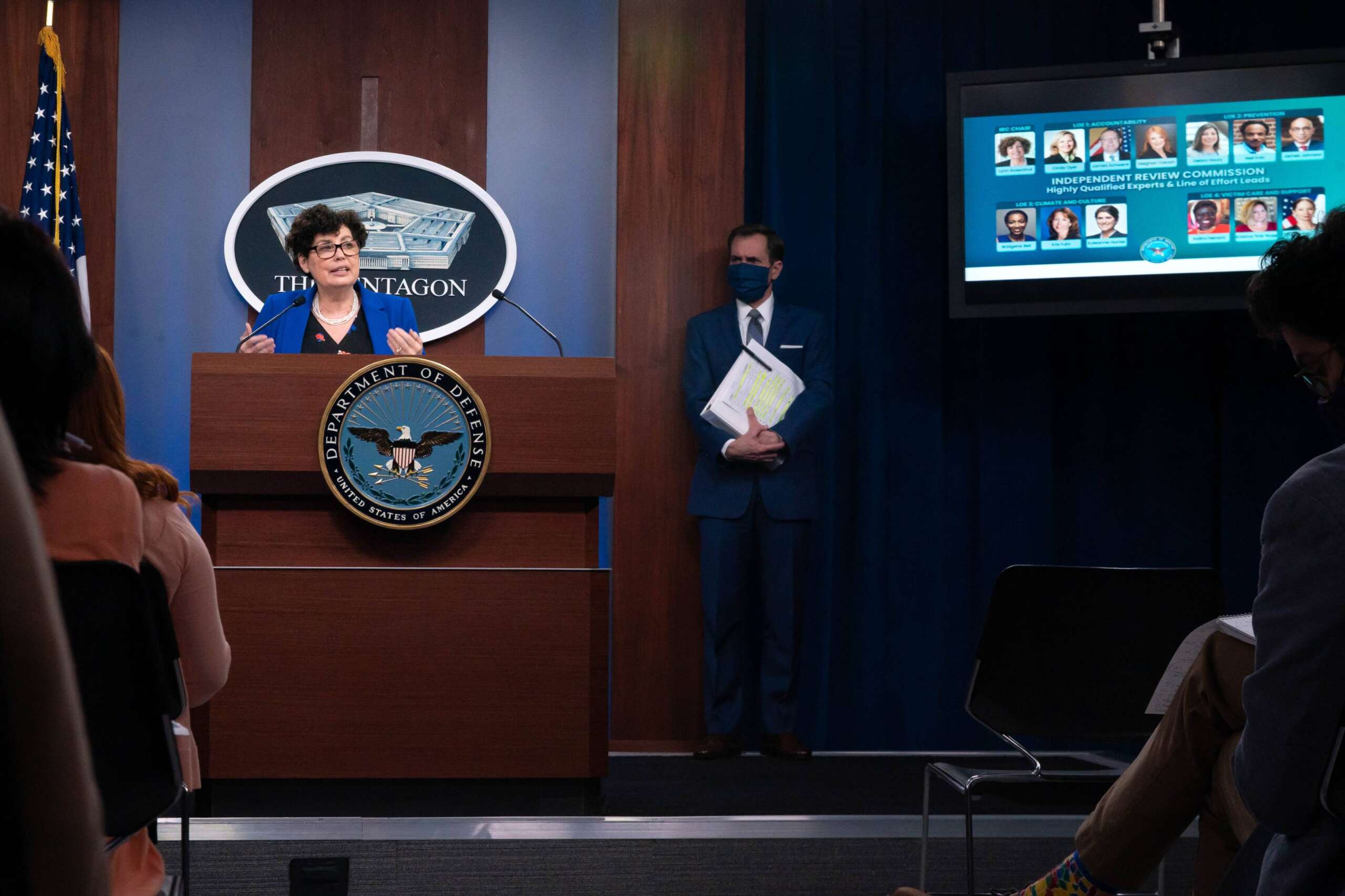
The commission said DoD should develop its own cyberharassment survey to distribute to troops.
Finally, the commission said leaders need to be better educated. Kirk-Cuomo agreed that digital literacy is still an issue within leadership.
“The leadership has to realize that this is an issue that is impacting the daily lives of their service members and not turn a blind eye to it,” she said.
Many critical tweeters questioned why people like Maj. Gen. Clyborne got involved in an “online squabble.”
“That’s the problem, because that’s how the majority of the leadership thinks at the moment,” Kirk-Cuomo said. “There’s got to be some kind of training for leadership for general officers to be like, ‘Hey, you have this tool in your toolbox to go after online harassment. Now you use it, and you need to address it when you see it.’”
What this means for women in the military
The military needs women. They have been serving since Deborah Sampson joined the Army in 1781 and sustained a saber wound to the head and a musket ball to the thigh.
DoD has made it abundantly clear it wants more women and more diversity in its ranks. In February, the Pentagon released its Women, Peace and Security Framework and Implementation Plan — a way for the department to encourage meaningful participation, development and employment in the joint force for all ranks and occupations in the defense and security sectors.
Elizabeth Phu, DoD’s principal director of cyber policy, stated upon the release of the strategy that DoD needs the top talent and bringing in all aspects of gender and race are key to developing that workforce.
“When you ignore any segment of the population, you run the risk of not grabbing the best talent available for critical missions. And so, in some sectors, the progress is a lot slower than others, but I do see progress overall,” she said.
Multiple studies from the RAND Corporation studies commissioned by DoD show women contributed to the military’s readiness and are beneficial to the services.
On top of that, DoD is pulling from a shrinking pool of potential recruits — about 25% of 17- to 24-year-olds are eligible to serve — to do more complex and skilled jobs relating to near-peer competition, space, cyber, data, artificial intelligence and coding.
Navy personnel chief Vice Adm. John Nowell recently told Congress that in the past three years the propensity of those eligible to serve dropped from 13% to 10%.
“Women are 51% of the population,” Clyborne, the assistant adjutant general of the Minnesota National Guard said. “Why would you exclude 51% of the talent pool? We know also from studies that diverse teams do better, they are more creative, and they provide better problem solving. We have women in our formation who need to know that they can achieve the greatest levels of success.”
Current service members, leaders, policy experts, retired generals and academics all told Federal News Network that online harassment is a major deterrent to women serving in the military.
“There’s a huge recruitment and retention issue regarding online harassment,” Hunter said. Hunter recently published research in the Marine Corps University Press’ Journal of Advanced Military Studies connecting online misogyny to a decrease in recruitment and retention of women in the military.
“The net result is women leaving the service due to feeling a lack of belonging and a lack of belief that their concerns will be adequately addressed,” the study found. Women were two to one more likely to say they were planning on leaving the military as soon as possible and cited online harassment as a primary reason.
Hunter described online harassment as death by a thousand cuts.
“DoD has invested an exorbitant amount of money in studies to figure out how to retain more women,” Kirk-Cuomo said.
However, at least one of the answers has been under the military’s nose the whole time.
“The vast majority of women I know who served in the military and gotten out. All of them say, they would never tell their daughter to join,” Sarah, one of the 30 women in the chat about @usemcee said. “Every single female service member I know has experienced online harassment. I cannot imagine that does anything positive in terms of retaining the best and brightest in the military. These wonderful, strong, intelligent, brave women don’t feel like they’re being treated as human beings by their peers.”
Copyright © 2024 Federal News Network. All rights reserved. This website is not intended for users located within the European Economic Area.
Scott Maucione is a defense reporter for Federal News Network and reports on human capital, workforce and the Defense Department at-large.
Follow @smaucioneWFED




